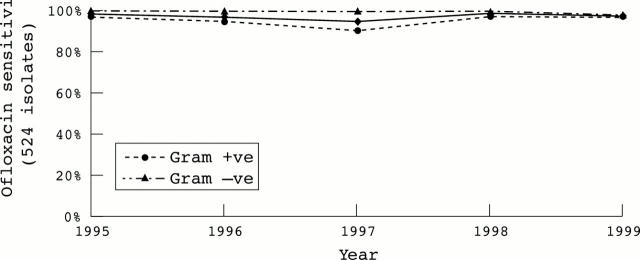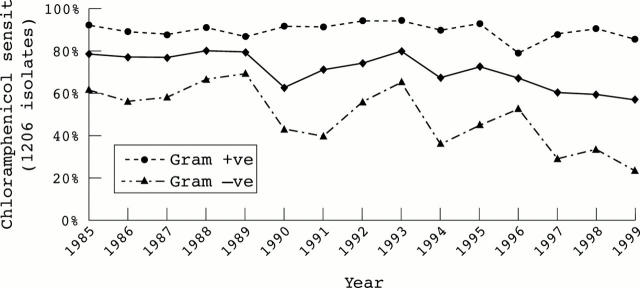Abstract
AIM—To document changes in the profile of bacterial isolates from cases of keratitis and changes in their susceptibility to first line antibiotic therapies. METHODS—A retrospective review was performed of all bacterial isolates from cases of keratitis seen between 1984 and 1999. In vitro laboratory susceptibilities to antibiotics were determined by the Kirby-Bauer disc diffusion method. The number of isolates, changes in the proportion of bacterial types, and the number that were fully resistant to monotherapy (ofloxacin), dual therapy (gentamicin and cefuroxime), and prophylactic treatment (chloramphenicol) were calculated. RESULTS—There were 1312 bacterial isolates over 16 years. Gram positive bacteria accounted for 54.7% of isolates and Staphylococcus species (33.4%) were the most frequently isolated organisms. During the study period there has been an increase in the proportion of Pseudomonas species isolates but no overall increase in the proportion of Gram negative isolates. There has not been an increase in the proportion of isolates resistant to ofloxacin since 1995 or an increase in resistance to the combination of gentamicin and cefuroxime. However, since 1984 there has been a significant increase in proportion of Gram negative organisms resistant to chloramphenicol (p=0.0019). CONCLUSIONS—An increase in the in vitro resistance of organisms to first line therapies for bacterial keratitis has not been observed. An increased resistance to chloramphenicol indicates that this drug is unlikely to provide prophylactic cover when Gram negative infection is a risk. Continued monitoring for the emergence of antibiotic resistance is recommended.
Full Text
The Full Text of this article is available as a PDF (134.9 KB).
Figure 1 .
Percentage of total isolates according to Gram stain.
Figure 2 .
Percentage of all isolates sensitive and partially sensitive to cefuroxime and gentamicin (solid line). Gram positive (broken line, circles) and Gram negative isolates (broken line, triangles) are shown separately.
Figure 3 .
Percentage of all isolates sensitive and partially sensitive to ofloxacin (solid line). Gram positive (broken line, circles) and Gram negative isolates (broken line, triangles) are shown separately.
Figure 4 .
Percentage of all isolates sensitive and partially sensitive to chloramphenicol (solid line). Gram positive (broken line, circles) and Gram negative isolates (broken line, triangles) are shown separately.
Selected References
These references are in PubMed. This may not be the complete list of references from this article.
- Ball P. Emergent resistance to ciprofloxacin amongst Pseudomonas aeruginosa and Staphylococcus aureus: clinical significance and therapeutic approaches. J Antimicrob Chemother. 1990 Dec;26 (Suppl F):165–179. doi: 10.1093/jac/26.suppl_f.165. [DOI] [PubMed] [Google Scholar]
- Baum J. L. Initial therapy of suspected microbial corneal ulcers. I. Broad antibiotic therapy based on prevalence of organisms. Surv Ophthalmol. 1979 Sep-Oct;24(2):97–105. doi: 10.1016/0039-6257(79)90127-9. [DOI] [PubMed] [Google Scholar]
- Baum J., Barza M. Topical vs subconjunctival treatment of bacterial corneal ulcers. Ophthalmology. 1983 Feb;90(2):162–168. doi: 10.1016/s0161-6420(83)34583-8. [DOI] [PubMed] [Google Scholar]
- Bowe B. E., Snyder J. W., Eiferman R. A. An in vitro study of the potency and stability of fortified ophthalmic antibiotic preparations. Am J Ophthalmol. 1991 Jun 15;111(6):686–689. doi: 10.1016/s0002-9394(14)76770-4. [DOI] [PubMed] [Google Scholar]
- Bower K. S., Kowalski R. P., Gordon Y. J. Fluoroquinolones in the treatment of bacterial keratitis. Am J Ophthalmol. 1996 Jun;121(6):712–715. doi: 10.1016/s0002-9394(14)70641-5. [DOI] [PubMed] [Google Scholar]
- Chin N. X., Neu H. C. Ciprofloxacin, a quinolone carboxylic acid compound active against aerobic and anaerobic bacteria. Antimicrob Agents Chemother. 1984 Mar;25(3):319–326. doi: 10.1128/aac.25.3.319. [DOI] [PMC free article] [PubMed] [Google Scholar]
- Daum T. E., Schaberg D. R., Terpenning M. S., Sottile W. S., Kauffman C. A. Increasing resistance of Staphylococcus aureus to ciprofloxacin. Antimicrob Agents Chemother. 1990 Sep;34(9):1862–1863. doi: 10.1128/aac.34.9.1862. [DOI] [PMC free article] [PubMed] [Google Scholar]
- Davison C. R., Tuft S. J., Dart J. K. Conjunctival necrosis after administration of topical fortified aminoglycosides. Am J Ophthalmol. 1991 Jun 15;111(6):690–693. doi: 10.1016/s0002-9394(14)76771-6. [DOI] [PubMed] [Google Scholar]
- Diamond J. P., White L., Leeming J. P., Bing Hoh H., Easty D. L. Topical 0.3% ciprofloxacin, norfloxacin, and ofloxacin in treatment of bacterial keratitis: a new method for comparative evaluation of ocular drug penetration. Br J Ophthalmol. 1995 Jun;79(6):606–609. doi: 10.1136/bjo.79.6.606. [DOI] [PMC free article] [PubMed] [Google Scholar]
- Garg P., Sharma S., Rao G. N. Ciprofloxacin-resistant Pseudomonas keratitis. Ophthalmology. 1999 Jul;106(7):1319–1323. doi: 10.1016/S0161-6420(99)00717-4. [DOI] [PubMed] [Google Scholar]
- Goldstein M. H., Kowalski R. P., Gordon Y. J. Emerging fluoroquinolone resistance in bacterial keratitis: a 5-year review. Ophthalmology. 1999 Jul;106(7):1313–1318. [PubMed] [Google Scholar]
- Hooper D. C., Wolfson J. S., Ng E. Y., Swartz M. N. Mechanisms of action of and resistance to ciprofloxacin. Am J Med. 1987 Apr 27;82(4A):12–20. [PubMed] [Google Scholar]
- Humphreys H., Mulvihill E. Ciprofloxacin-resistant Staphylococcus aureus. Lancet. 1985 Aug 17;2(8451):383–383. doi: 10.1016/s0140-6736(85)92510-3. [DOI] [PubMed] [Google Scholar]
- Hyndiuk R. A., Eiferman R. A., Caldwell D. R., Rosenwasser G. O., Santos C. I., Katz H. R., Badrinath S. S., Reddy M. K., Adenis J. P., Klauss V. Comparison of ciprofloxacin ophthalmic solution 0.3% to fortified tobramycin-cefazolin in treating bacterial corneal ulcers. Ciprofloxacin Bacterial Keratitis Study Group. Ophthalmology. 1996 Nov;103(11):1854–1863. doi: 10.1016/s0161-6420(96)30416-8. [DOI] [PubMed] [Google Scholar]
- Jones D. B. Initial therapy of suspected microbial corneal ulcers. II. Specific antibiotic therapy based on corneal smears. Surv Ophthalmol. 1979 Sep-Oct;24(2):97, 105-16. doi: 10.1016/0039-6257(79)90128-0. [DOI] [PubMed] [Google Scholar]
- Kaatz G. W., Seo S. M. Mechanism of ciprofloxacin resistance in Pseudomonas aeruginosa. J Infect Dis. 1988 Sep;158(3):537–541. doi: 10.1093/infdis/158.3.537. [DOI] [PubMed] [Google Scholar]
- Knauf H. P., Silvany R., Southern P. M., Jr, Risser R. C., Wilson S. E. Susceptibility of corneal and conjunctival pathogens to ciprofloxacin. Cornea. 1996 Jan;15(1):66–71. [PubMed] [Google Scholar]
- Kunimoto D. Y., Sharma S., Garg P., Rao G. N. In vitro susceptibility of bacterial keratitis pathogens to ciprofloxacin. Emerging resistance. Ophthalmology. 1999 Jan;106(1):80–85. doi: 10.1016/S0161-6420(99)90008-8. [DOI] [PubMed] [Google Scholar]
- Maffett M., O'Day D. M. Ciprofloxacin-resistant bacterial keratitis. Am J Ophthalmol. 1993 Apr 15;115(4):545–546. doi: 10.1016/s0002-9394(14)74467-8. [DOI] [PubMed] [Google Scholar]
- McDermott M. L., Tran T. D., Cowden J. W., Buggé C. J. Corneal stromal penetration of topical ciprofloxacin in humans. Ophthalmology. 1993 Feb;100(2):197–200. doi: 10.1016/s0161-6420(13)31672-8. [DOI] [PubMed] [Google Scholar]
- McLeod S. D., DeBacker C. M., Viana M. A. Differential care of corneal ulcers in the community based on apparent severity. Ophthalmology. 1996 Mar;103(3):479–484. doi: 10.1016/s0161-6420(96)30668-4. [DOI] [PubMed] [Google Scholar]
- Neu H. C. Microbiologic aspects of fluoroquinolones. Am J Ophthalmol. 1991 Oct;112(4 Suppl):15S–24S. [PubMed] [Google Scholar]
- O'Brien T. P., Maguire M. G., Fink N. E., Alfonso E., McDonnell P. Efficacy of ofloxacin vs cefazolin and tobramycin in the therapy for bacterial keratitis. Report from the Bacterial Keratitis Study Research Group. Arch Ophthalmol. 1995 Oct;113(10):1257–1265. doi: 10.1001/archopht.1995.01100100045026. [DOI] [PubMed] [Google Scholar]
- Ofloxacin monotherapy for the primary treatment of microbial keratitis: a double-masked, randomized, controlled trial with conventional dual therapy. The Ofloxacin Study Group. Ophthalmology. 1997 Nov;104(11):1902–1909. [PubMed] [Google Scholar]
- Petroutsos G., Guimaraes R., Pouliquen Y. The effect of concentrated antibiotics on the rabbit's corneal epithelium. Int Ophthalmol. 1984 Jun;7(2):65–69. doi: 10.1007/BF00165106. [DOI] [PubMed] [Google Scholar]
- Price F. W., Jr, Whitson W. E., Collins K. S., Gonzales J. S. Corneal tissue levels of topically applied ciprofloxacin. Cornea. 1995 Mar;14(2):152–156. [PubMed] [Google Scholar]
- Raviglione M. C., Boyle J. F., Mariuz P., Pablos-Mendez A., Cortes H., Merlo A. Ciprofloxacin-resistant methicillin-resistant Staphylococcus aureus in an acute-care hospital. Antimicrob Agents Chemother. 1990 Nov;34(11):2050–2054. doi: 10.1128/aac.34.11.2050. [DOI] [PMC free article] [PubMed] [Google Scholar]
- Snyder M. E., Katz H. R. Ciprofloxacin-resistant bacterial keratitis. Am J Ophthalmol. 1992 Sep 15;114(3):336–338. doi: 10.1016/s0002-9394(14)71801-x. [DOI] [PubMed] [Google Scholar]
- Vance-Bryan K., Guay D. R., Rotschafer J. C. Clinical pharmacokinetics of ciprofloxacin. Clin Pharmacokinet. 1990 Dec;19(6):434–461. doi: 10.2165/00003088-199019060-00003. [DOI] [PubMed] [Google Scholar]
- Walker S., Diaper C. J., Bowman R., Sweeney G., Seal D. V., Kirkness C. M. Lack of evidence for systemic toxicity following topical chloramphenicol use. Eye (Lond) 1998;12(Pt 5):875–879. doi: 10.1038/eye.1998.221. [DOI] [PubMed] [Google Scholar]
- Wilhelmus K. R., Hyndiuk R. A., Caldwell D. R., Abshire R. L., Folkens A. T., Godio L. B. 0.3% ciprofloxacin ophthalmic ointment in the treatment of bacterial keratitis. The Ciprofloxacin Ointment/Bacterial Keratitis Study Group. Arch Ophthalmol. 1993 Sep;111(9):1210–1218. doi: 10.1001/archopht.1993.01090090062020. [DOI] [PubMed] [Google Scholar]
- Wise R. Macrolide progress. J Antimicrob Chemother. 1990 Jul;26(1):5–6. doi: 10.1093/jac/26.1.5. [DOI] [PubMed] [Google Scholar]






